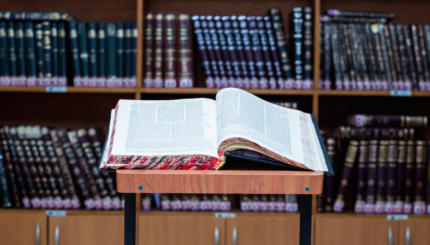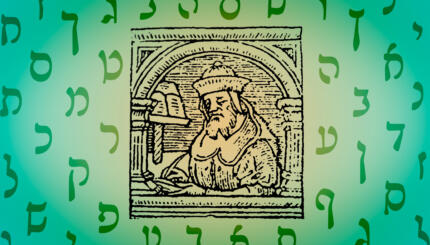Click here for part 1 of this series.
Rabbi Benay Lappe instructed us in the traditional method of Talmud study, employing a famous passage from tractate Bava Kamma dealing with laws of damages. We began by memorizing the Mishnah, and then moved on to the Gemara (this time in the original Aramaic text). We were expected to obtain an Aramaic dictionary, and prepare our translation prior to class without consulting an English version.
If I thought Talmud study was difficult before, this was nearly impossible. The Hebrew and English translations I’d used while studying tractate Berakhot had added punctuation, vowels, and enough additional words to make a sentence understandable. But the Talmud is written in an Aramaic shorthand where many of the words are missing and speakers are often called “he” rather than by their actual names. When we shared our translations in class, none of us had come up with the same one.
Thus the first thing I learned from Rabbi Lappe was how fluid the Talmud text was, how open to interpretation. I saw that if not for Rashi’s commentary, which cleared up much confusion, the Talmud truly would be a closed book. Eventually, I became familiar with common expressions the rabbis employed in their arguments, as well as the limited vocabulary used in discussing damages.
With translation no longer so onerous, I came to realize that the rabbis had done something revolutionary. They had taken the Torah verse “eye for eye, tooth for tooth” (Exodus 21:24) and proved that it doesn’t mean actual physical retaliation by an injured party. Rather, the person responsible must pay monetary compensation. The Talmud demonstrated how the rabbis uprooted a problematic Torah text and gave it a new meaning that kept Torah relevant in their changed society.
The next year Rabbi Aaron Katz arrived at our synagogue. Personal problems had forced him to leave Israel, where he had over thirty years of Orthodox yeshiva experience, plus rabbinic ordination from the Chief Rabbinate. I was heavily involved in writing
Rashi’s Daughters
, and he graciously agreed to help me study sections of Talmud that dealt with women. He also insisted that I learn those passages most Talmud scholars knew. If my work was going to be taken seriously, I had to “walk the walk and talk the talk.”
During the seven years Rabbi Katz lived in Los Angeles, we studied Talmud together once a week, him using the Hebrew and Aramaic versions, and me the new Schottenstein English/Hebrew interlinear translation (a boon for American Talmud students). We delved into the Tosafot, medieval commentators—including Rashi’s grandsons—who disagreed with Rashi, and had terrific arguments over whose interpretation was correct. We chose our texts by subject, which meant we jumped from chapter to chapter, eventually criss-crossing the entire Talmud. I learned that Rashi, and even more so his grandson Rabbenu Tam, held quite “liberal” opinions when it came to Jewish laws concerning women.
I completed my Rashi’s Daughters trilogy shortly after Rabbi Katz obtained a position in Florida. I started researching my new series,
Rav Hisda’s Daughter
, by reading about the history of Jews in Babylonia, which relied almost completely on the Talmud. My publisher urged me to hire a research assistant. Just when I thought I’d never find anyone with the qualifications I needed, Henry showed up at Torah study class. He had just graduated with a bachelor’s in Jewish Studies, had several years of Talmud study in a Jerusalem yeshiva, and was fluent in Hebrew and Aramaic.
We started working together, beginning with tractate Berakhot and continuing through each tractate in turn, finding passages of Talmud that mentioned Rav Hisda, his daughter, and the two rabbis who ultimately married her. It took over a year, and by then I realized sorcery was going to be an integral part of the new series. So we went through the entire Talmud again, tractate by tractate, searching for every mention of demons, magic, and enchantresses. We found far more than I expected, some stories were quite fantastic, but that will be the subject of another blog post. Our third trip through the Gemara focused on the people who populated the Talmud, their daily lives and their community.
I learned how this small group of beleaguered rabbis struggled to establish new Jewish practices after the destruction of Jerusalem’s Holy Temple. It took centuries, but the Talmud they created became the source of Jewish law and tradition for the last 1200 years. This was a story I had to tell. And, as a feminist, I was determined to write it from a woman’s perspective. That she turned out to be a learned, powerful enchantress made it even more compelling.
Like this post? Join the conversation through MyJewishLearning’s weekly blogs newsletter.
Gemara
Pronounced: guh-MAHR-uh, Origin: Aramaic, a compendium of rabbinic writings and discussions from the first few centuries of the Common Era. The Talmud comprises Gemara and the Mishnah, a code of law on which the Gemara elaborates.
Talmud
Pronounced: TALL-mud, Origin: Hebrew, the set of teachings and commentaries on the Torah that form the basis for Jewish law. Comprised of the Mishnah and the Gemara, it contains the opinions of thousands of rabbis from different periods in Jewish history.
Torah
Pronunced: TORE-uh, Origin: Hebrew, the Five Books of Moses.
yeshiva
Pronounced: yuh-SHEE-vuh or yeh-shee-VAH, Origin: Hebrew, a traditional religious school, where students mainly study Jewish texts.



